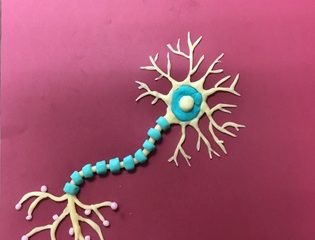
We voted! I hope you did too!
Heres what we are reading today!
“Most research on mind-wandering has characterized it as a mental state with contents that are task unrelated or stimulus independent. However, the dynamics of mind-wandering — how mental states change over time — have remained largely neglected. Here, we introduce a dynamic framework for understanding mind-wandering and its relationship to the recruitment of large-scale brain networks.”
“Language is not simply about hearing sounds or moving our mouths. When our brain is “doing language,” it projects abstract structure. The modality (speech or sign) is secondary. “There is a misconception in the general public that sign language is not really a language,” said Berent. “Part of our mandate, through the support of the NSF, is to reveal the complex structure of sign language, and in so doing, disabuse the public of this notion.””
“A new study shows that computer technology known as machine learning is up to 93 percent accurate in correctly classifying a suicidal person and 85 percent accurate in identifying a person who is suicidal, has a mental illness but is not suicidal, or neither. These results provide strong evidence for using advanced technology as a decision-support tool to help clinicians and caregivers identify and prevent suicidal behavior, says John Pestian, PhD, professor in the divisions of Biomedical Informatics and Psychiatry at Cincinnati Children’s Hospital Medical Center and the study’s lead author.”
“Oxytocin is often referred to as the ‘love hormone’ due to its role in human behaviours including sexual arousal, recognition, trust, anxiety and mother-infant bonding. It is produced by the hypothalamus – an area of the brain that controls mood and appetite – and stored in the pituitary gland, a pea-sized organ that sits in the base of the skull.”
“Gerhardt and Rice colleagues have created the first low-cost, easy-to-use optogenetics hardware platform that biologists who have little or no training in engineering or software design can use to incorporate optogenetics testing in their labs.”
“The findings, published today in the academic journal Proceedings of the National Academy of Science (PNAS), describe how networks of connected brain regions are supported by underlying brain structure at a microscopic scale.
The research, titled ‘Relationship between cortical myeloarchitecture and electrophysiological networks’, was led by PhD student Ben Hunt working in the Sir Peter Mansfield Imaging Centre in the School of Physics and Astronomy.”



17 Comments
EmmaPessereau · November 9, 2016 at 7:54 pm
After reading the article about the computer technology that was able to classify a person as suicidal, I was blown away. Although I am aware I may not always be upto date on the latest tech, this was something I never would have deemed tangible. It especially touched me having friends who have suicidal tendencies, and knowing now that there might be a way to get help before suicide is attempted. I wonder how the 5 questions were such accurate depictions of suicidal thought, when they could depend on the participant’s varying mood. But I was very interested in how the machine was able to calculate quantifiable measurements based off human non-verbals. It is my hope that medicine and technology continue to partner in ways that protect and advance our well-being.
RachelSemple · November 10, 2016 at 2:22 pm
I read the article about new technology that is helpful in identifying potentially suicidal individuals by looking at their verbal and nonverbal language. I was very hopeful while reading this article, suicide prevention is very important and this type of technology can be used in numerous positive ways. I believe that this type of technology should be available in high schools and college, especially in places known to have high rates of suicide. the earlier warning signs are caught, the easier it is to help the struggling individual come to a better place mentally. Time is crucial in these situations, and I am very hopeful that technology like this will continue to improve and continue to become more available to the general public.
mariecote · November 11, 2016 at 2:43 pm
I read the article on oxytocin with regards to empathy. It’s interesting that not many studies have focused on the effect of medical conditions like CDI and HP, disorders that have to do with the hypothalamus and the posterior pituitary gland, the latter of which stores hormones (oxytocin and ADH) produced in the hypothalamus. According to the study, people with CDI or HP had lower levels of oxytocin, and thus performed less well on emotion recognition tests than did people of the control group. I find it interesting that they recognized that low levels of oxytocin, which corresponds to worse emotion expression recognition, may affect one’s psychological well-being. I had only heard of hormone replacement therapy being used for estrogen, but it makes sense that it could be a method used to increase oxytocin levels as well. And given that empathy helps everyone’s mental health, it is important to address low levels of oxytocin that may interfere with emotional behavior.
mictom16 · November 14, 2016 at 10:34 am
The article “Machine Learning Automatically Identifies Suicidal Behavior Using Patient’s Own Words” was very interesting. It declared that the computer algorithm that it had was 93% accurate at distinguishing a suicidal patient. I think this is extremely important to help diagnose and treat individuals. Technology certainly has its benefits but it can never take the place of an actual physician or psychologist.
mictom16 · November 14, 2016 at 10:50 am
The article “People With Low Oxytocin Levels Suffer Reduced Empathy” gave a light summary of the results of a study. The study looked at patients with hypothyroidism and cranial diabetes insipidus who had decreased amounts of oxytocin and compared the results of those patients with a control group. This reminds me of mothers with postpartum depression who usually exhibit lower levels of oxytocin related to a lack of bonding with the infant.
linnearamirez · November 14, 2016 at 11:23 am
I found the article “How Human Brains Do Language: One System, Two Channels” interesting because of my experience learning Spanish and English at a young age and American Sign Language in high school. This study examines English speaking subjects responses to sign language. The authors concluded that the human brains can understand language if its spoken or signed. I wold be interested in seeing the results of this study using another language and/or using English speaking subjects responses to languages they are familiar with.
linnearamirez · November 14, 2016 at 11:41 am
The article “People with Low Oxytocin Levels Suffer Reduced Empathy” looks at low oxytocin levels as a result of medical disorders effects emotional behavior and performance on tasks involving empathy. The authors tested oxytocin levels in HP and CDI individuals compared to healthy individuals but that a larger sample size is required for statistical significance. This study is preliminary and I would be interested in a study with further subjects and one that explains the methods of the experiment. This article does not detail the experimental design and I think that should be included to understand the results.
EmmaPessereau · November 28, 2016 at 1:19 pm
I read the article about brain fat in relation to mental health, and I found the analogy of the brain to be thought of as a bunch of electrical wires very helpful and interesting. Having a visual and reading that the speed of transmission was controlled by the amount of electrical insulation around the wires made a lot of sense to me as a visual learner. I was pleased to recognize myelin as the fat that insulated the “wires”. I liked that the technique was non-invasive – Magnetoencephalography – I believe we covered it in the first few weeks of the quarter, and I found it really productive that there was a way to gather research without hurting the patient. By the end of the article I did wonder what kind of conclusions they drew from measuring the amount of myelin against the information from the MEG measurements. I wondered also if they would have had to wait until the patient’s were a certain age and their brain’s were fully formed to take these measurements.
EmmaPessereau · November 28, 2016 at 1:41 pm
In the article about mind-wandering, I found the section on spontaneous thought to be very thought provoking. I have often wondered where such random thoughts came from in my mind because it often feels like the burst out of nowhere. The flexible and deliberate constraint that we use on our minds to pay attention and retain information during lectures sounded all too familiar. The “automatic in nature” constraint can be thought of as a family of mechanisms that operate outside of cognitive control to hold attention on a restricted set of information – this made me wonder if there was a link to introversion and extroversion, as it used the example of not being able to disengage from a buzzing fly in a quiet library or silence an emotional concern. This part of the article reminded me of past research I have read that stated that introverts will be more sensitive to external stimuli, while extroverts are less sensitized to external stimuli and therefore may prefer to go to a crowded party or study in a louder area of the library.
gmli · November 29, 2016 at 1:44 am
The article “Machine Learning Automatically Identifies Suicidal Behavior Using Patient’s Own Words” left me amazed. Just today I watched a video on how medical professionals should be more personal with their patients, rather than diagnose them through tests, and charts. I can see how the computer may analyze the words, but I wonder if it may take into account the tone of voice or emotions that are in the words. But, if it is truly 93 percent accurate, then it will be a lifesaving breakthrough.
cathyvu · December 2, 2016 at 12:10 am
The article titled “Machine Learning Automatically Identifies Suicidal Behavior Using Patient’s Own Words” made me question why I haven’t heard about this study before. I believe that it is a breakthrough in research and can help prevent countless suicides if people are tested. It’s scary how far technology has developed to be able to indicate those that are suicidal with a 93% accuracy.
cathyvu · December 2, 2016 at 1:14 am
The article about how people with low oxytocin levels can suffer with reduced empathy was interesting! I think the side effects of a decreased amount of the hormone oxytocin is expected since it is referred to as a “love hormone”, which can in return affect the levels of empathy. It’s unfortunate that these side effects can occur as a result of a medical operation. I believe this study can expand beneficially and the basic experiment presented could be effective in measuring the levels of oxytocin.
rachelcarlson · January 22, 2017 at 7:50 pm
I love this! I find it very interesting that people do not consider sign language a bonafide language. There is a common misconception that thought is linguistic, so language too must take the form of words in a sentence or phrase. Not so! We think symbolically — why can’t a language, too, be symbolic?
kylie.wong18 · January 23, 2017 at 7:02 pm
I read the article, “Machine Learning Automatically Identifies Suicidal Behavior Using Patient’s Own Words,” and I think it is a great step because when I hear of technology, I do not hear of much that actually is geared toward our mental well being. It is nice to know that there are people out there concerned not only about physical health but mental as well. I think it is extremely helpful to be able to accurately identify not only people with suicidal ideation but mental disorders in general because a lot of the time, people with them do not seek help or realize that they have one. Also, the idea of being able to intervene and hopefully save someone’s life is very comforting. However, I also feel that identifying someone who is suicidal is going into their deepest, most personal thoughts, so it is somewhat intrusive. Overall though, it is a positive step forward, and I hope it is able to make a big impact.
Venus · January 31, 2017 at 11:12 pm
I read the article about brain “fat” and its key to mental health. This article referred to myelination as “fat.” In the study conducted, the researchers used MEG to measure the different electrical activities occurring in our brain. In addition to MEG, the researchers used MRI to measure the amount of myelin around the areas of electrical conduction. To no surprise, the areas with more myelin corresponded to more electrical activity. This is also probably because myelin helps electrical signals be transmitted quicker and more efficiently. Hopefully with this method of looking at brain activity, we will be able to delve deeper into diseases and mental disorders.
madisonklein118 · March 4, 2018 at 3:02 pm
The article about using technology to detect if someone is suicidal or has a mental illness was very interesting to me. I wish the article had explained how they got to the 93% number and how many participants were used. It scares me a little bit to think that technology is capable of diagnosing things like this. I am a California certified crisis counselor and I know that putting words into someones mouth or labeling their experience when they are not ready can be very dangerous. Cal Poly actually recently sent out an email with a survey for students to take and it basically diagnosed them with GAD general anxiety disorder, depression, eating disorders etc. I have a major problem with this because sometimes labeling someones experience can be dangerous and even more detrimental to them. Using the language they are most comfortable with is the key which is why in person counseling will always be better than technology in my opinion.
readings in Psychology for 8 november 2016 #intropsych #psychology #PsychScience #biopsych – Psychology Facts · November 8, 2016 at 3:08 pm
[…] from Laura’s Psychology Blog http://laurafreberg.com/blog/?p=3381 […]